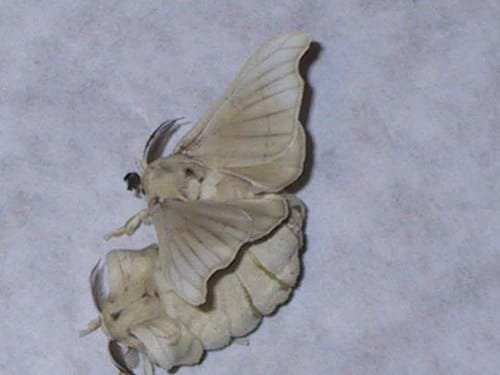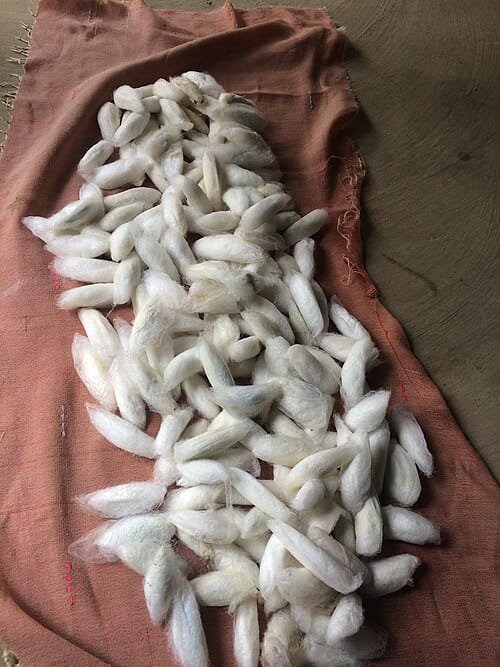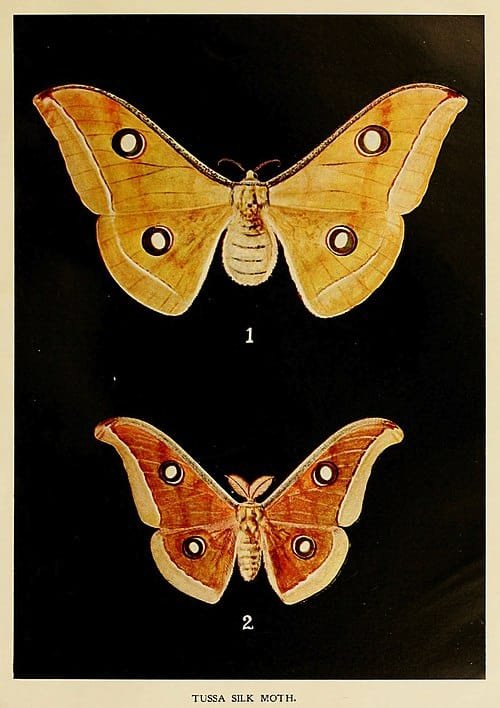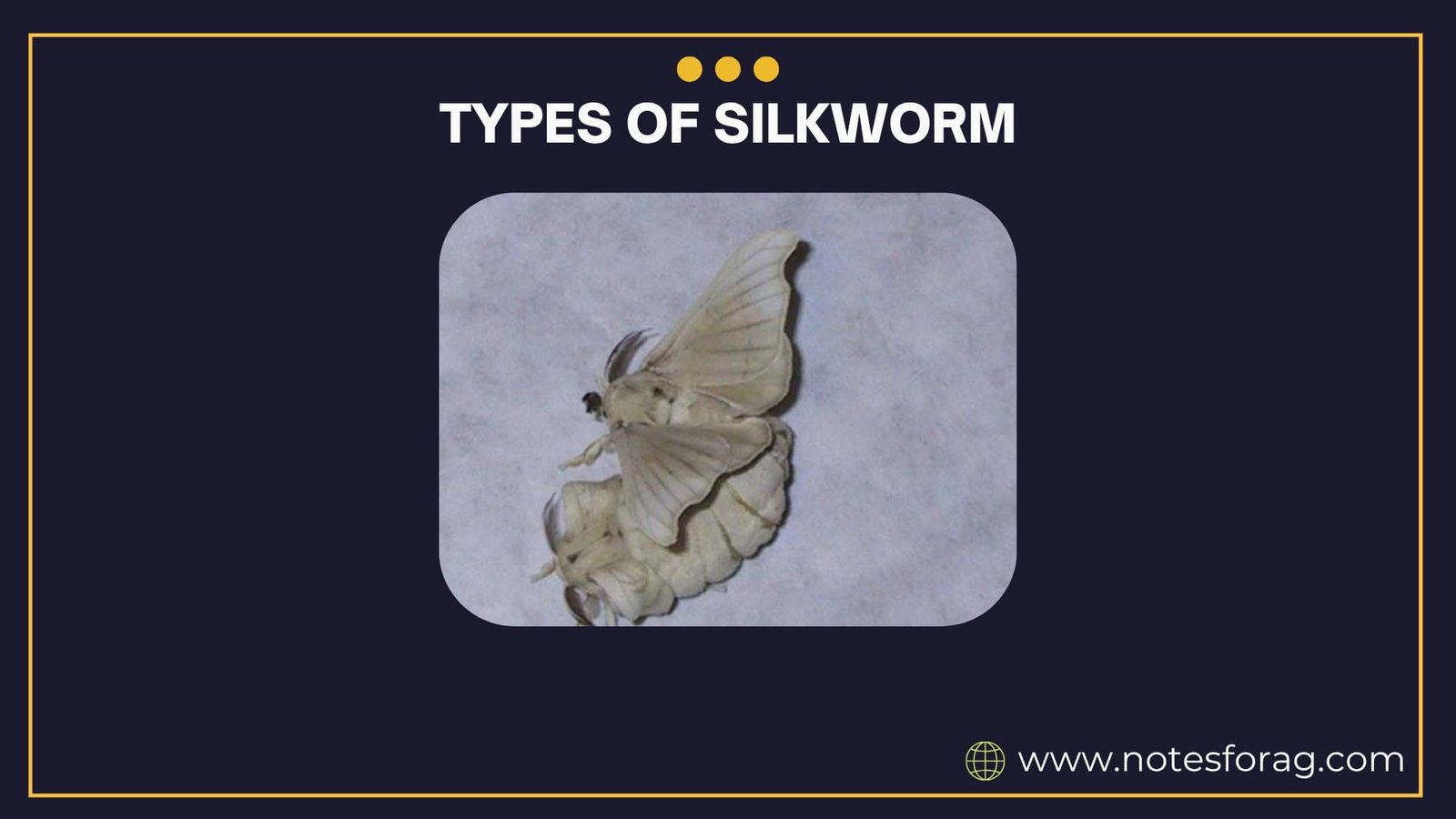A silkworm is the larval stage of a silk-producing moth, most commonly Bombyx mori. These caterpillars spin protective cocoons made of silk threads, which are harvested to produce natural silk fabric. Different species of silkworms feed on specific host plants and produce various types of silk used in clothing and textiles.
Introduction to Sericulture in India
India is the second-largest producer of silk in the world, after China. Sericulture, or silk farming, plays a crucial role in the rural economy by providing employment opportunities to millions. The diversity of India’s climatic and ecological conditions supports the cultivation of various types of silkworms. The primary types of silkworms reared in India are mulberry, eri, tasar, and muga. These silkworms differ in their host plants, silk quality, lifecycle, and regional distribution.
Summary of Silkworms
- India cultivates four main silkworm varieties mulberry, eri, tasar, and muga each producing unique silk and suited for different climates.
- Mulberry silk is prized for its fine, lustrous quality, while non-mulberry silks (eri, tasar, muga) offer diversity in texture, color, and eco-friendly appeal.
- Non-mulberry silks are deeply tied to regional traditions and support rural livelihoods, adding cultural and economic value across many Indian states.
Table of Contents
Major Types of Silkworms in India
1. Mulberry Silkworm (Bombyx mori)

Overview
Mulberry silkworm is the most widely cultivated silkworm in India and globally. It is a domesticated species that feeds exclusively on the leaves of the mulberry plant (Morus spp.). This type of silk is known for its fine quality, softness, luster, and strength.
Distribution
Mulberry sericulture is practiced mainly in the southern states like Karnataka, Tamil Nadu, Andhra Pradesh, and West Bengal. Karnataka alone contributes over 60% of India’s mulberry silk production.
Lifecycle and Rearing
The lifecycle of Bombyx mori includes egg, larva (caterpillar), pupa (within cocoon), and adult moth. The larval stage is the most important for silk production. Rearing involves controlled environmental conditions, feeding the larvae with fresh mulberry leaves, and providing hygienic trays for cocoon formation.
Types of Mulberry Silkworm Races
Bivoltine
Produces two generations per year; known for superior silk quality and preferred for commercial rearing.
Multivoltine
Produces more than five generations per year; commonly reared in tropical areas due to their adaptability.
Silk Characteristics
Mulberry silk is white or off-white, strong, elastic, and has a natural sheen. It is used in high-end garments, saris, and upholstery.
2. Eri Silkworm (Samia ricini)

Overview
Eri silkworms are semi-domesticated and are also known as castor silkworms because they primarily feed on castor (Ricinus communis) leaves. Eri silk is also called “Ahimsa silk” because the silk is spun from open-ended cocoons after the moths emerge, making it non-violent.
Distribution
Eri cultivation is predominantly found in Assam and other northeastern states, as well as in parts of Bihar and Odisha.
Lifecycle and Rearing
Eri worms have a multivoltine lifecycle. The rearing process is relatively simple, and cocoons are spun as open-mouthed structures, which are then degummed and spun into yarn.
Silk Characteristics
Eri silk is wooly, warm, and durable. Though less shiny than mulberry silk, it is ideal for shawls, jackets, and furnishings. It is gaining popularity among eco-conscious consumers.
3. Tasar Silkworm (Antheraea mylitta)

Overview
Tasar silkworms are wild or semi-wild species that feed on forest trees such as Terminalia arjuna (Arjun) and Terminalia tomentosa (Asan). Tasar silk is known for its deep golden color and is often used in traditional wear.
Distribution
Tasar cultivation is practiced in Jharkhand, Chhattisgarh, Odisha, Madhya Pradesh, and Maharashtra. Tribal communities often engage in Tasar rearing as a traditional occupation.
Lifecycle and Rearing
Tasar worms are reared outdoors on forest trees. The lifecycle includes wild egg collection, leaf feeding in natural habitat, and cocoon harvesting. Tasar silk farming is largely seasonal and depends on the availability of host plants.
Silk Characteristics
Tasar silk has a rich texture and natural golden-brown color. It is less refined than mulberry silk but stronger and more breathable. It is used for saris, kurta fabrics, and accessories.
4. Muga Silkworm (Antheraea assamensis)
Overview
Muga silk is unique to Assam and is considered the pride of the region. The Muga silkworm feeds on som (Machilus bombycina) and soalu (Litsea polyantha) leaves. This silk is the most expensive among Indian silks.
Distribution
Muga sericulture is practiced exclusively in Assam, under specific ecological conditions.
Lifecycle and Rearing
Muga worms are semi-domesticated and reared on outdoor host trees. The climate and vegetation of Assam are ideal for Muga rearing, which includes traditional methods passed down through generations.
Silk Characteristics
Muga silk is known for its natural golden-yellow hue and high durability. It improves in shine and texture after every wash. Muga is used in traditional Assamese garments like mekhela chador and is a symbol of cultural heritage.
Comparison of Different Types of Silkworms
| Type | Host Plant(s) | Region | Silk Color | Notable Features |
|---|---|---|---|---|
| Mulberry | Mulberry (Morus spp.) | South India | White | Fine, lustrous, most common |
| Eri | Castor (Ricinus), Kesseru | Northeast India | Cream/Wooly | Ahimsa silk, spun not reeled |
| Tasar | Arjun, Asan | Central India | Golden-brown | Wild silk, coarse texture |
| Muga | Som, Soalu | Assam | Golden-yellow | Shiny, exclusive to Assam |
Economic and Cultural Importance
Each silkworm type contributes to regional economies and traditions. Mulberry silk powers industrial sericulture, while Tasar, Eri, and Muga provide livelihoods to tribal and rural communities. Muga and Tasar have ceremonial and cultural value, especially in northeastern and central India.
Challenges in Silkworm Rearing
Silkworm farming in India faces challenges such as:
- Disease outbreaks among silkworms
- Fluctuating market demand and prices
- Climate change impacting host plant availability
- Limited access to high-quality seed and modern equipment
Government Initiatives and Research
The Central Silk Board (CSB) under the Ministry of Textiles supports sericulture through:
- Research and development of disease-resistant silkworm breeds
- Training programs for farmers
- Financial subsidies and infrastructure development
- Export promotion of Indian silk products
Conclusion
India’s diverse climate and rich biodiversity allow it to cultivate all four major types of silkworms, each with unique characteristics and applications. While mulberry silk leads in volume and commerce, non-mulberry varieties like eri, tasar, and muga are deeply rooted in indigenous culture and ecological balance. With growing awareness about sustainable and eco-friendly textiles, traditional Indian silks are gaining global recognition. Through innovation, policy support, and community engagement, sericulture in India continues to thrive as both an art and a livelihood.
Frequently Asked Questions (FAQs)
What are the major types of silkworms reared in India?
India rears four main types of silkworms: Mulberry, Eri, Tasar, and Muga. Mulberry silkworms feed on mulberry leaves and produce fine white silk. Eri silkworms eat castor and kesseru leaves and give a soft, wool-like silk. Tasar silkworms are reared on forest trees like Arjun and Asan, and they produce coarse golden-brown silk. Muga silkworms are found only in Assam and produce golden-yellow silk. Each type grows in different regions and is important for both income and tradition.
Which silkworm produces the finest silk?
The Mulberry silkworm makes the finest and softest silk in the world. It is raised indoors under clean, controlled conditions, which helps improve the quality of the silk. Mulberry silk is shiny, smooth, and strong, making it perfect for high-end clothing like saris, gowns, and export-quality fabrics. It also makes up more than 90% of India’s total silk production.
What makes Muga silk unique?
Muga silk, found only in Assam, is special because of its natural golden color, high strength, and shine that increases after every wash. It is also resistant to sunlight and lasts for many years. Because Muga silk is only produced in a specific region and made in a traditional way, it has received a Geographical Indication (GI) tag that protects its identity and heritage.
Why is Eri silk called ‘Ahimsa silk’?
Eri silk is called Ahimsa silk because it is made without killing the insect. The moth is allowed to come out of the cocoon naturally before the silk is collected. Unlike other types where cocoons are boiled, Eri silk is spun from open-ended cocoons. This makes it a popular choice for people who support ethical and eco-friendly fashion.
Related Articles

